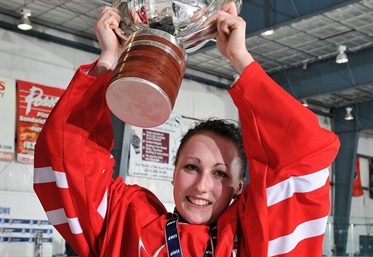Campbell & kids ready for action
Campbell & kids ready for action
Canada adopts “in with the new” policy

 A rookie at the 2015 IIHF Ice Hockey Women’s World Championship in Malmo, Jessica Campbell led Canada to U18 Women’s Worlds gold in 2010 with her OT goal against the United States. Photo: Matthew Manor / HHOF-IIHF Images
A rookie at the 2015 IIHF Ice Hockey Women’s World Championship in Malmo, Jessica Campbell led Canada to U18 Women’s Worlds gold in 2010 with her OT goal against the United States. Photo: Matthew Manor / HHOF-IIHF Images
After all, eight skaters who won an incredible gold in Sochi were not on the list, and only one, Hayley Wickenheiser, was understandably absent. She has had foot surgery and is convalescing.
But, no, there was no error. Darraugh is taking Canada to places it has never really gone before, crafting a lineup much younger and inexperienced than ever. The newcomers are all veterans of U18 Women’s World Championship play from several years ago, but many familiar names will not be playing.
The goaltenders will be a blend of new and newer as incumbents Shannon Szabados plays in the SPHL and Charline Labonte pursues her master’s degree.
The “veteran” is Genevieve Lacasse, whose patience is finally being rewarded. She was the third goalie at the 2012 and 2013 Women’s Worlds as well as Sochi, but she never played a minute of game action. After leading the Boston Blades to the Clarkson Cup earlier this month, she is destined to get into her first WW game.
The other goalies are Ann-Renee Desbiens, who has only WW18 experience from 2011, and Emerance Maschmeyer, who helped Harvard get to the NCAA championship game last week.
As for the departing skaters, it’s almost entirely a case of older players being replaced by younger ones. Gone are Jayna Hefford (37), Gillian Apps (34), Meaghan Mikkelson (30), Meghan Agosta (28), Catherine Ward (28), Haley Irwin (26), and Melodie Daoust (23).
Incoming skaters are all in the 19-23 range except for Courtney Birchard (25) and Bailey Bram (24), both of whom played in the 2012 and 2013 Women’s Worlds but were unable to crack the Sochi lineup.
Continue readingIn all, there are eight newcomers whose only previous experience was several years ago at the WW18 level – Halli Krzyzaniak (20), Brigette Lacquette (22), Emily Clark (19, the youngest), Sarah Davis (22), Jamie Lee Rattray (22), Kelly Terry (22), Jillian Saulnier (23), and Jessica Campbell (22).
Campbell might be the name most familiar to fans of the women’s game from the incoming group of players. The last major tournament she played for Canada was back in 2010 when she scored the overtime winner in the gold-medal game in Chicago, giving Canada its first gold in WW18 play.
“It was an unbelievable experience,” Campbell said after practice in Toronto the other day before the Canadians left for Malmo. “I still get chills thinking about the U18 title. It was our first one, and to be a part of that was so special and something I’ll never forget. A bunch of the rookies here still talk about it.”
Indeed, and not coincidentally, there are five teammates with her this year who were playing in that game in 2010 – Terry, Rattray, Saulnier, Davis, and Lacquette.
But after that great win, Campbell was relegated to the fringes as she trained hard to make the difficult jump from junior to senior hockey. In her case, that growth started with going to Cornell University in the fall of 2010.
“When I was looking at schools in grade 11 and 12,” she explained, “I wanted to go somewhere that I could take advantage of academically, so I looked at Ivy League right away, and Cornell was the best fit. The development was unbelievable. It was the best of both worlds for hockey and school.”
The transition from U18 to NCAA hockey was a formidable one for Campbell, but she handled it well and dedicated herself to learning and growing as a player, on ice and off, physically and skills-wise.
“The best thing about Cornell was that every day we were practising with the best players, both Canadian and American,” she enthused. “Development-wise that was huge for all of us. We pushed each other, but of course when you throw on your country’s jersey it’s all different.”
A superstar in U18 does not necessarily make a superstar at the senior level, and Campbell knew all to well her U18 abilities were nowhere good enough as they were.
“I knew I had a lot of things to work on to get to the senior level, but I stuck to my game, which is playing with energy and speed all over the ice, being relentless,” she continued. “But I also needed to work on my defensive game, and I did all of that at Cornell. I worked with the coaches, watched video, worked on the little things which may not have seemed obvious to work on at the time, but now that I’ve established those habits and skills, it makes all the difference in the world at this level.”
While the casual fan loses touch with graduating U18 players for a while, Hockey Canada does not. In fact, it encourages players, develops programs for them, and does as much as it can to help nurture aspiring players beyond the U18 program.
“Hockey Canada has development teams, an under-22 team,” Campbell related. “Every year we go to a tournament in Germany around Christmas, so that’s an opportunity to get more experience against national teams in some European countries. It’s really good for us to play at the senior level. Hockey Canada invested in us and explained what we needed to do in those transition years because at any time you can get your opportunity to play at the senior level. You have to be ready.”
Those words are easier said than accomplished. For any young woman longing to play at the Women’s Worlds, every passing year is a missed opportunity, and every year is more nerve-wrecking and competitive. Campbell didn’t make the Olympic team, but she grew in confidence throughout her four years at Cornell.
“I think this year was different for me,” she agreed about her tryouts for Malmo 2015. “Obviously, coming out of the last Olympics, it was devastating for me not to be centralized with that team – lots of players felt like that – but at the same time I knew I wasn’t ready and it wasn’t my time. In my last year of university, I really focused on preparing for post-Olympics, so I would be ready. Going into tryouts last September, I firmly believed that, and I played that way. I was confident. I think this year is my chance and my time.”
Only time will tell, of course, but that time is fast approaching. Pretty soon players such as Marie-Philip Poulin, Rebecca Johnston, and Tara Watchorn – not long ago rookies themselves – will be asked to lead a much younger team. It’s a gamble of sorts, but it’s only the start of a four-year cycle with PyeongChang as the final destination.
“It’s obviously a big change this year,” Campbell said, “but as players you have to trust Hockey Canada in whatever direction they want to go. No matter if you’re a rookie or vet, you have to bring it every time and compete for a spot. That makes it exciting for the young players, but we still have some incredible leadership here. Half the team has been in the Olympics, so that experience helps the younger players.”
Campbell scored the golden goal five years ago as a 17-year-old, and in the interim she and her teammates have trained hard to reach the next level. Coach Darraugh has put his faith in the next generation, and the time is now.
Back to Overview























































